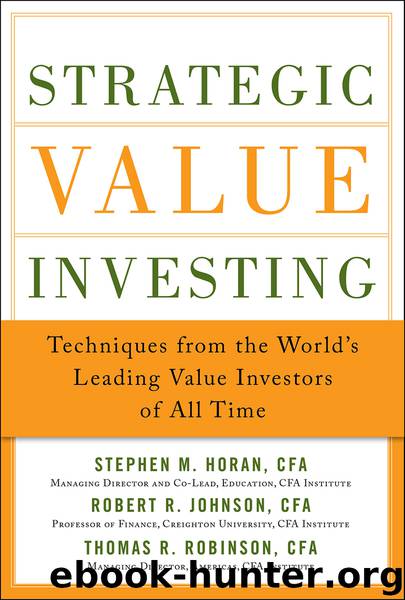Strategic Value Investing by Stephen Horan

Author:Stephen Horan
Language: eng
Format: epub
Publisher: McGraw-Hill Education
Published: 2014-03-19T16:00:00+00:00
FIGURE 9-1
S&P 500 Price-to–book value ratio since 2000.
We discuss the price-to-book ratio, other measures of absolute and relative value, how they are calculated, and how we might use them to distinguish value stocks from growth stocks in more detail in Chapter 6. Here, we focus on how to use them to estimate intrinsic value.
Evidence on the Book-to-Market Effect
The evidence that high BV/MV stocks outperform low BV/MV stocks is quite pervasive. Starting with Rosenberg, Reid, and Lanstein (1985), many researchers have documented that even after controlling for many other variables (risk, in particular), firms with high BV/MV ratios outperform stocks with low BV/MV ratios. One of the most widely referenced studies was coauthored by none other than Dr. Eugene Fama, the academic who developed the efficient market hypothesis (EMH).5 In a seminal academic paper entitled “The Cross Section of Expected Stock Returns,” Fama and French (1980) found evidence that firms with high book-to-market ratios outperform firms with low book-to-market ratios on a consistent basis. These findings have stood the test of time. Very few relationships are as strong and persistent as this so-called book-to-market effect.6
The evidence of a book-to-market effect is not limited to U.S. equity markets. Fama and French (1998) found that over a 21-year time period from 1975 through 1995, sorting on book-to-market equity, value stocks outperformed growth stocks in 12 of 13 major developed global markets. The difference between average returns on global portfolios of high and low BV/MV stocks was an impressive 7.68 percent per year. As you would expect, researchers have examined whether a book-to-market effect exists in emerging markets. Notably, van der Hart, Slagter, and van Dijk (2003), using data from 1982 to 1999 and in a study of nearly 3,000 firms from 32 emerging markets, find that high BV/MV stocks outperform low BV/MV stocks by approximately 10 percent annually. Thus, the book-to-market effect appears to be pervasive across the global investment landscape.
Download
This site does not store any files on its server. We only index and link to content provided by other sites. Please contact the content providers to delete copyright contents if any and email us, we'll remove relevant links or contents immediately.
Hit Refresh by Satya Nadella(9038)
The Compound Effect by Darren Hardy(8808)
Change Your Questions, Change Your Life by Marilee Adams(7634)
Nudge - Improving Decisions about Health, Wealth, and Happiness by Thaler Sunstein(7615)
The Black Swan by Nassim Nicholas Taleb(7010)
Deep Work by Cal Newport(6878)
Daring Greatly by Brene Brown(6444)
Rich Dad Poor Dad by Robert T. Kiyosaki(6401)
Principles: Life and Work by Ray Dalio(6208)
Man-made Catastrophes and Risk Information Concealment by Dmitry Chernov & Didier Sornette(5921)
Playing to Win_ How Strategy Really Works by A.G. Lafley & Roger L. Martin(5916)
Digital Minimalism by Cal Newport;(5663)
Big Magic: Creative Living Beyond Fear by Elizabeth Gilbert(5610)
The Myth of the Strong Leader by Archie Brown(5424)
The Slight Edge by Jeff Olson(5346)
Discipline Equals Freedom by Jocko Willink(5284)
The Motivation Myth by Jeff Haden(5155)
Stone's Rules by Roger Stone(5026)
The Laws of Human Nature by Robert Greene(4996)
